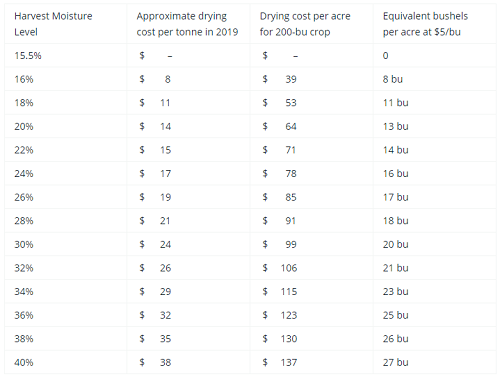Late planting combined with below-average heat unit accumulation this year means Ontario’s corn crop is behind in maturity from where we would normally expect it to be. Autumn is here in full swing and many parts of the province have already experienced frost.
If corn is not fully mature by the time the first frost hits, frost damage can occur. Frost damage is evident in water-soaked leaves or plant material that eventually turns brown (Figure 1). Yield loss is directly related to the stage of maturity and the amount of leaf tissue killed. If kernels are still in the dough stage, even a light frost can cause significant yield loss. The “early dent stage”, when most kernels have small indentations in the crown, is generally considered the “cut-off point” where plants can withstand minor frost damage (e.g. leaves only) and still produce a reasonable grain yield. Until the corn reaches black layer and grain moisture is below 35%, there is potential for yield loss if frost comes early.
Early frost also affects grain quality. This will be most evident in low test weights. And while this is not a #testweightdebate, and many markets are available for low test weight corn, harvest will be more challenging. Frost-damaged kernels can be smaller and misshapen, pithy and undeveloped, and highly susceptible to breakage with more fines produced during handling.
When to harvest
Frost-damaged grain takes longer than mature grain to dry in the field. When frost kills the plant, the biological maturing process is halted. Now the grain must dry by evaporation/dehydration of moisture from inside the kernels, which depends heavily on the weather conditions and takes more time for immature corn. This extended drying period can lead to increased field losses, and can also increase risk of ear moulds developing.
Once the kernel moisture is below 35%, harvest can begin. Don’t wait too long – once the moisture level of frost-damaged corn is adequate, harvest can be started. Frost-killed corn tends to have higher levels of stalk breakage, meaning the longer harvest is delayed, the higher the risk of lodging. Lodged corn takes longer to harvest and increases harvest losses. If plants seem stable and ear moulds have not set in, harvest can be postponed, but monitor the fields carefully for any change in conditions.
How to harvest
Low test-weight grain can be more susceptible to breakage during combining , and frost-damaged cobs can break into small pieces. Set the combine carefully, and monitor the grain quality throughout harvest. Smaller kernels may require more aggressive shelling, but this can cause higher breakage. Higher fan speeds can blow out more chaff and fines for a cleaner sample, but may increase yield loss when smaller and lighter kernels are also blown out the back.
Field Drying
If frost-damaged corn is harvested at higher moisture levels, it must be dried for good storage, and there will be a cost.
It is tempting to leave corn in the field to let it dry naturally, before harvesting and paying for drying. However, increased risk of field loss, lodging and quality loss can negate any benefit of waiting. Table 1 shows the estimated drying cost per tonne and per acre for a 200-bushel/acre yield, and the equivalent bushels (based on $5/bushel) to the drying cost. Drying costs are based on published charts from Ontario-based elevators for the 2019 season. To estimate the benefit of partial field drying, subtract the cost of the later-harvested moisture from the early-harvest moisture.

For example, if you harvest corn at 30% moisture with a yield of 200 bushels per acre, it will cost you about $99 per acre to dry it. Technically you could afford to lose 20 bushels of yield by waiting for natural dry-down (at $5/bushel) and you’d still make more money by waiting. However, MOST corn in MOST years needs SOME drying – so harvest moisture would more likely be, say, 22% instead of 30%. 200-bushel corn at 22% moisture will cost around $71 to dry. The net savings from waiting for partial dry-down are about $28 per acre ($99 minus $71), or close to 6 bushels of equivalent loss. Will you lose 6 bushels of yield while you wait for field dry-down? That depends on the quality of the crop still in the field, the variety, and the extent of the frost damage.
There may be times when it’s worthwhile to bite the bullet, harvest early, and pay for a little extra drying if it means your crop quality will be better. If you’re anticipating a low-test-weight crop, keep a close eye on quality changes in the field, and be prepared to harvest if the crop starts to degrade.
Source : Field Crop News